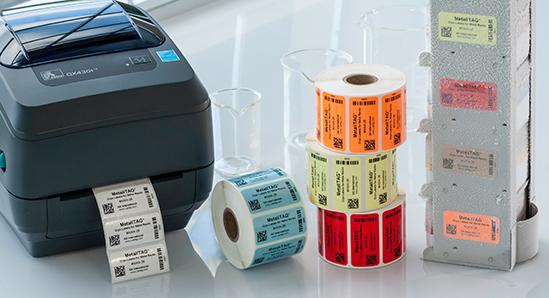Choose the right label for the right temperature
The first and most important consideration when choosing labels for samples that will be stored in the cold is to assess which temperature(s) are needed for your samples. Cryogenic labels are designed to stick to containers in temperatures as low as -269°C (-452.2°F) and can be used to store samples like human and animal tissues, primary cells, and cell lines. Deep-freeze labels are an appropriate choice for samples that are stored in temperatures as low as –80°C, including protein, RNA, and DNA samples, as well as stocks of certain valuable reagents. Note that some labels might be exposed to extreme heat as well (i.e. autoclaving), so ensure that the temperature range of the label is appropriate for your experimental conditions.
Tailor your label choice to your container
There are a variety of containers in different shapes and sizes, and your labels must be able to affix properly to each one, so you don’t lose track of your samples. As such, the application surface is a critical factor in choosing the appropriate label. Some labels are more suited to plastic or glass containers, whereas certain labels are designed specifically for metal, which can be labeled directly or identified with cryogenic tags.
Moreover, the size and shape of your container will determine if your label will fit securely, with enough space to carry all the necessary information required to identify each sample. Several kinds of specialty labels are available, depending on the application. For example, cryostraws used in in vitro fertilization (IVF) clinics should be used exclusively for cryogenically storing eggs, sperm, and embryos. Labeling and storing PCR tubes in the refrigerator can also be made more efficient using the PCR-TagTrax™. If you’re planning on replacing the label on your container (e.g. when labeling cryo boxes or plates), you may want to opt for a label with a removable adhesive (yes, there exists removable cryogenic labels).
Finally, you should consider whether your samples need to be labeled or re-labeled out of cold storage, covered in frost. Most cryo labels will not stick to tubes that are cold and/or wet and must be applied at room temperature prior to cryogenic storage. For samples already stored at extremely low temperatures that cannot be thawed, CryoSTUCK® labels are a good option, as they will immediately stick to tubes that are already cryogenically frozen, requiring zero cure time before being re-immersed in liquid nitrogen.
Select an appropriate printing method
Once you’ve chosen the right labels, you’ll also need to choose an appropriate printing method to ensure that the information on your labels doesn’t smudge or fade. You can find a full breakdown of current printing technologies here. In general, both digital (inkjet and laser) and thermal (direct thermal and thermal-transfer) printers can be used to print either cryogenic or deep-freeze labels. Note that each has its own unique advantages, depending on the experimental conditions.
Other considerations for picking a label
So, you’ve finally picked an appropriate set of labels, but there are a few features you wanted to add, like an efficient means of sample tracking or extra security. Keep in mind that certain kinds of sample tracking technology, like radio-frequency identification (RFID), can only be used with deep-freeze labels, making barcoded labels a more suitable choice for samples stored cryogenically. For more information about our RFID labeling solutions, visit this page.
For added security, cryogenic tamper-evident and destructible labels will tear up upon any attempt to remove them, making them an option for samples like patient specimens, which often require storage in protected containers prior to analysis.
LabTAG by GA International is a leading manufacturer of high-performance specialty labels and a supplier of identification solutions used in research and medical labs as well as healthcare institutions.
